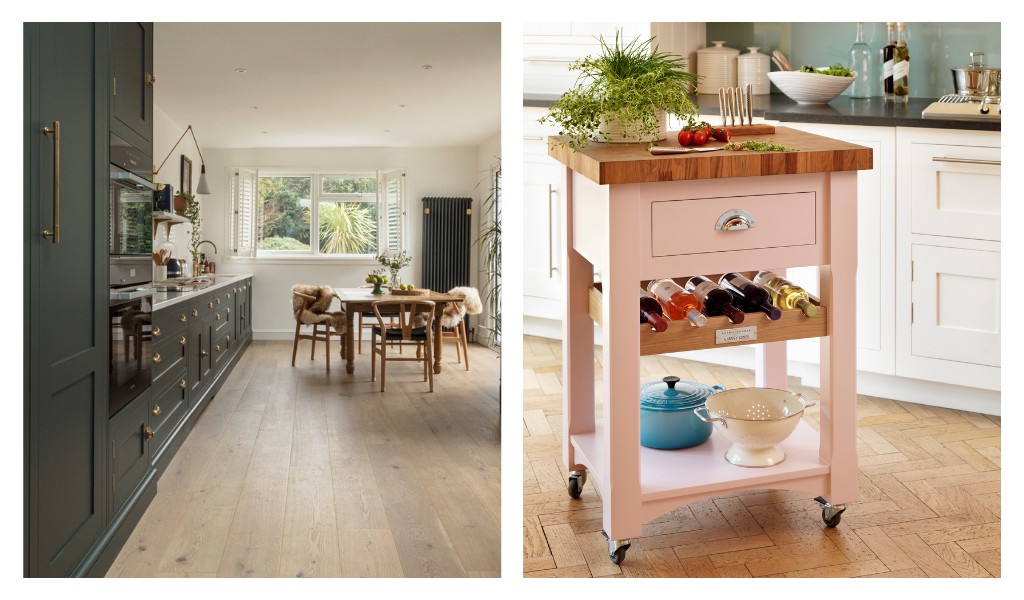How To Design A Free Standing Kitchen
A free-standing kitchen offers a unique blend of flexibility and style, allowing homeowners to create a culinary haven that perfectly complements their space and needs. Whether you’re designing a new kitchen or revamping an existing one, understanding the fundamentals of free-standing kitchen design empowers you to create a space that is both functional and aesthetically pleasing. This article will guide you through the process, offering a comprehensive approach to designing a free-standing kitchen that meets your culinary aspirations.
1. Determining the Layout and Functionality
The starting point for any successful kitchen design is a clear understanding of the space available and the functionality desired. Unlike traditional kitchens with fixed cabinetry, free-standing kitchens offer greater flexibility in layout and appliance placement. Consider the following aspects:
- Available Space: Measure the dimensions of your kitchen area, accounting for existing features like windows, doors, and structural elements. This will give you a clear picture of the potential footprint for your free-standing kitchen setup.
- Work Triangle: The work triangle is a fundamental concept in kitchen design, encompassing the refrigerator, sink, and stovetop. Optimize its flow by considering the distance between each element. Aim for a triangle with sides ranging from 4 to 7 feet to ensure efficient and comfortable movement.
- Traffic Flow: Plan the layout to ensure smooth and unimpeded movement within the kitchen. Consider high-traffic areas and minimize obstacles to create a spacious and comfortable work environment.
- Appliance Choices: Select appliances that fit your cooking needs and style. Consider the size, features, and energy efficiency of each appliance, ensuring compatibility with your overall design aesthetic.
By carefully considering these elements, you lay the foundation for a functional and efficient free-standing kitchen that meets your culinary requirements.
2. Choosing the Right Materials and Finishes
The selection of materials and finishes significantly impacts the overall look and feel of your free-standing kitchen. Consider the following factors:
- Countertops: Explore various countertop materials, such as granite, marble, quartz, and stainless steel, each offering distinct aesthetic and functional qualities. Budget, durability, and maintenance considerations guide your choice.
- Cabinets: Choose cabinet styles that align with the kitchen’s overall theme. Consider the material, such as wood, laminate, or metal, the finish, such as painted, stained, or distressed, and the hardware, like knobs or pulls.
- Backsplash: The backsplash serves both functional and aesthetic purposes. Consider a contrasting material to the countertop or a complementary one to enhance the overall look. Tile, stone, metal, and glass are popular backsplash options.
- Flooring: Select flooring materials that are durable, easy to clean, and aesthetically compatible with the overall kitchen design. Tile, hardwood, laminate, and vinyl are commonly used options.
The careful selection of materials and finishes ensures that your free-standing kitchen seamlessly blends aesthetic appeal with practicality.
3. Incorporating Storage and Organization
A well-organized kitchen is a joy to work in. Efficient storage solutions are crucial for keeping your free-standing kitchen tidy and functional. Consider the following tips:
- Maximize Vertical Space: Utilize upper cabinets, shelves, and drawers to store less frequently used items, keeping countertops clear for everyday use.
- Invest in Drawer Dividers: Drawer dividers create order within your cabinets, helping to organize utensils, cookware, and other items. Utilize different sizes to optimize space.
- Utilize Wall-Mounted Storage: Wall-mounted organizers, shelves, and racks offer additional storage without taking up valuable floor space. They are ideal for storing spices, cookbooks, and other frequently used items.
- Consider a Pantry: If space allows, a dedicated pantry provides ample storage for dry goods, canned items, and other pantry staples. Optimize the pantry space with shelves, drawers, and pull-out baskets for efficient organization.
By implementing strategic storage solutions, your free-standing kitchen can seamlessly transition from a culinary haven to a beautifully organized space.
Designing a free-standing kitchen involves a thoughtful approach to functionality, aesthetics, and organization. By carefully considering layout, materials, and storage solutions, you can create a kitchen that reflects your personal style and enhances your culinary experience. Embrace the flexibility and creativity that free-standing kitchens offer, meticulously crafting a space that is both a haven of culinary exploration and a testament to your design vision.

Free Thinking How To Use Standalone Furniture In Your Kitchen

Freestanding Kitchens 17 Flexible Ways To Create A Rustic Look Real Homes

Ideas For A Freestanding Kitchen

25 Trendy Freestanding Kitchen Cabinet Ideas Digsdigs

Modular Kitchen Pantry Cabinet Design Ideas Cafe

What Is A Freestanding Kitchen Pros Cons And Ideas Harvey Jones

Free Standing Furniture Kitchen Design My Decorative

Freestanding Kitchen Islands Masterclass Kitchens

What Is A Freestanding Kitchen Pros Cons And Ideas Harvey Jones

Free Standing Kitchens Gallery Kitchen Design Modular Fitting
How to Decorate a Kitchen with Standalone Furniture and Appliances : Transform Your Kitchen into a Stylish and Functional Space

Decorating a kitchen with standalone furniture and appliances can create a unique and personalized space that reflects your style while maintaining functionality. The beauty of standalone pieces is their versatility; they can be easily moved, rearranged, or replaced without the need for a complete remodel. Here, we will explore various tips and ideas to help you effectively decorate your kitchen using standalone furniture and appliances.First, consider the layout of your kitchen. Start by measuring the space to determine the best placement for your furniture and appliances. Standalone items can create distinct zones within your kitchen, such as a cooking area, dining nook, or prep space. Make sure to leave enough room for movement and ensure that your kitchen remains functional. A well-thought-out layout can enhance both the aesthetics and the usability of the kitchen.Next, choose a color scheme that complements your existing decor. When selecting standalone furniture, opt for colors that match or contrast beautifully with your kitchen’s color palette. For instance, if you have a predominantly white kitchen, a vibrant blue or red standalone table can serve as a stunning focal point. Additionally, consider the materials of your furniture. Wood, metal, and glass can each bring a different vibe to your kitchen, so think about the overall ambiance you want to create.When it comes to appliances, standalone models offer both style and functionality. For example, a retro-style refrigerator can add a fun touch to your kitchen while providing ample storage. Similarly, a standalone range or oven can serve as a statement piece. Be sure to consider the scale of your appliances in relation to your kitchen size; oversized appliances in a small kitchen can feel cramped, while smaller models might get lost in a large space.Incorporating seating options is another great way to enhance your kitchen design. Standalone stools or chairs can create a cozy breakfast bar or a full dining setup. Choose seats that are comfortable and match the overall aesthetic of the room. If you’re short on space, consider stools that can be tucked under tables when not in use.Moreover, don’t overlook the importance of lighting. Standalone furniture can be complemented by stylish pendant lights or floor lamps that add warmth and brightness to the space. Consider pendant lighting above a kitchen island or dining table to create an inviting atmosphere.Finally, accessorizing is key to making your kitchen feel complete. Add decorative items like potted herbs, colorful dishware, or artwork that resonates with your personal style. These touches will make your kitchen feel lived-in and welcoming.With these tips, you can transform your kitchen into a stylish and functional space using standalone furniture and appliances. Embrace creativity and let your personality shine through in your kitchen decor.
Tips 1:
Experiment with different layouts before committing to a final design. This can help you find the most efficient and visually appealing arrangement for your kitchen.
FAQ
welcome to Coohom
Please check with customer service before testing new feature.
https://kitchenowa.com/how-to-design-a-free-standing-kitchen/https://www.coohom.com/article/how-to-decorate-a-kitchen-with-standalone-furniture-and-appliances

